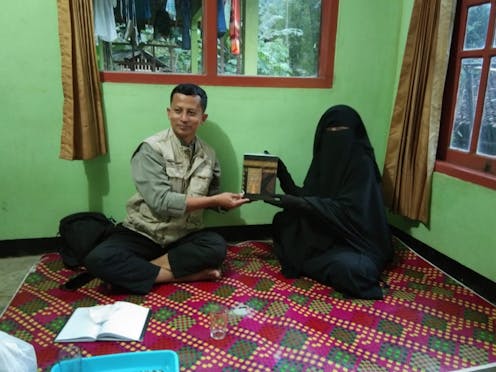
For decades, the U.S. government has sent aid to countries plagued by terrorism, believing that the money could help other nations tackle extremism. Money matters, but it alone isn’t enough to prevent terrorism.
An explosion at a mosque in northern Afghanistan killed more than 30 people on April 22, 2022, just days after blasts at schools in Kabul killed six.
These were the latest in a long string of terrorist attacks in Afghanistan. The Islamic State conducted 365 terrorist attacks in Afghanistan that caused 2,210 casualties in 2021 alone.
The United States, meanwhile, has spent approximately US$91.4 billion on foreign aid to Afghanistan since 2001, while other countries gave billions more. Most of this money went toward Afghanistan’s military.
The U.S. spent more than $1.1 billion on Afghanistan in fiscal 2021, and $1 billion on aid in fiscal 2020.
As a doctoral candidate researching how to get militants to adopt more moderate positions and stop committing violence, I have spoken with 23 former Indonesian terrorist detainees since October 2020 to study their experiences. These people planned, facilitated or otherwise took part in bombings and attacks on civilians.
My research shows that international aid does not stop terrorists from carrying out violent acts, because most counterterrorism projects do not directly involve or appeal to detained and released terrorists.
Speaking with terrorists
I have found that listening to ex-terrorists is the best approach to understanding how and why they walk away from terrorism.
When I spoke with former Indonesian terrorists through video meetings and calls, they all told me that they once cared only about exterminating America and its allies. This is because they thought these countries were trying to repress Muslims worldwide.
They also justified their violent jihad as a way to enforce a caliphate, a term that refers to an all-encompassing Muslim state.
Less than half of the 23 former terrorists that I spoke with participated in deradicalization programs, designed to move people away from extremism, while they were in prison. But all of them were part of such programs, sponsored by nonprofit organizations and the Indonesian government, after their release.
All of the former terrorists also went on to receive vocational training, and some also got money from the Indonesian government and nonprofits to start small businesses.
Others received psychological counseling, or participated in talks on religion. Some participated in outdoor retreats organized by the Indonesian police, with hiking and other recreational activities.
A few of the ex-terrorists I spoke with acknowledged that the government helped them pay for their children’s school tuition.
These people began to shift their views, and move away from extremism, after they developed a strong sense of community support and respect for government and police authorities.
“I started to change when the police treated me well, and my community accepted me for who I am,” explained one female former terrorist who was a “bride” – a term used to describe a suicide bomber. The police captured her just before she could carry out an attack in Bali in 2016.
Terrorism funding
Parts of Indonesia, a Southeast Asian country with the world’s largest Muslim population, are considered a haven for terrorism – though the number of terrorist attacks has recently declined there. It remains a transit and destination hub for Islamic militants.
Indonesia received almost $5 million in 2020 from U.S. Agency for International Development alone to contain violent extremism. It received the third largest amount of money from the U.S. for this kind of programming after Somalia and Bangladesh.
The U.S. has spent an estimated $2.8 trillion on counterterrorism from fiscal 2002 through 2017, according to the Stimson Center, a nonprofit think tank in Washington, D.C.
But even extensive international aid isn’t a sure fix for ending terrorism.
Afghanistan and Iraq are two examples of countries that receive big donations from the U.S. and other countries each year but still struggle with violent radicalism.
Most of this money and work focuses on helping governments and local organizations carry out programs to fight extremism. These might include workshops for government officials focused on addressing terrorism and training sessions for women on how to start small businesses.
However, these programs typically do not directly involve former terrorist inmates and their families. This matters, because it mattered to the individuals I spoke with when they were included in counterterrorism projects. This is one of the big reasons they changed their ways, they told me.
Aid doesn’t reach former terrorists
Major donor countries like the U.S. have increasingly acknowledged the role of foreign aid in fighting against extremism. Many countries, including the U.S., see that extremism can be politically destabilizing and pose international security concerns.
But at the same time, the incidence of terrorism in countries that get large amounts of international funding, including Afghanistan, Indonesia, Pakistan and Mali, shows that international aid is an insufficient counterterrorism measure.
In Indonesia, for example, the USAID gave $24 million from 2018 to 2023 for an anti-extremism project called Harmoni.
This project carries out workshops for state officials about prison management and handling terrorist detainees, among other programs.
But Harmoni does not include a key constituency – detained or released terrorists and their families – in their work.
This kind of strategy makes it very difficult, if not impossible, to actually reform extremists.
This model, according to my research, is common in counterextremism projects funded by international aid.
Involving terrorists
Donor countries, governments and partner organizations working to prevent extremism can involve released terrorists and their families in various ways – including providing vocational, financial, psychological, religious, educational and even recreational programs.
Many countries still need international aid to fight terrorism, but it will work more effectively only when also embracing former terrorist convicts and their families.
Without targeted, inclusive interventions in extremism, I believe the world will continue to see more wasted aid when addressing terrorism.
Bernard Loesi receives funding from Southeast Center, the University of Washington.
This article was originally published on The Conversation. Read the original article.







